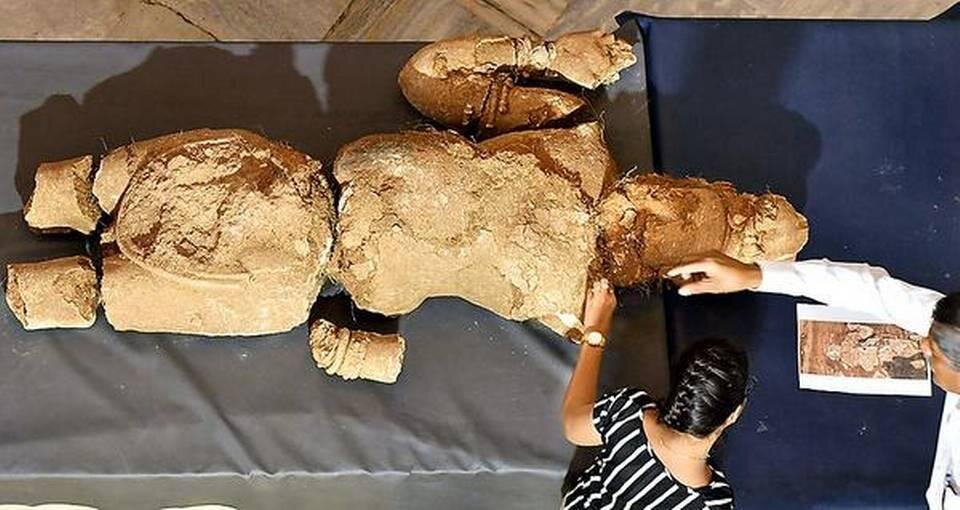Important Facts For Prelims (30th April 2019) | 30 Apr 2019
Bodhisattva Figure Unearthed 
- Recently, a 1.74-meter Bodhisattva figure was unearthed from Phanigiri in Telangana.
- It is life size stucco Bodhisattva figure, which was created by craftsmen at Phanigiri at the peak of Ikshvaku dynasty rule, nearly 1700 year ago.
Bodhisattva
- A person who has attained prajna, or Enlightenment, but who postpones Nirvana in order to help others to attain Enlightenment. Individual Bodhisattvas are the subjects of devotion in certain sects and are often represented in painting and sculpture.
Phanigiri
- It is a Buddhist site in Suryapet district, Telangana. It dates back to the 1st Century before common era(BCE), The place consists of a Buddhist complex which is adorned with a massive stupa along with two apsidal halls with stupas in it.
Ikshvaku dynasty
- The dynasty ruled in the eastern Krishna River valley of India, from their capital at Vijayapuri(modern Nagarjunakonda in Andhra Pradesh) during approximately 3rd and 4th centuries CE. The Ikshvakus are also known as the Andhra Ikshvakus or Ikshvakus of Vijayapuri to distinguish them from their legendary namesakes.
- The Ikshvaku kings were Shaivites and performed Vedic rites, but Buddhism also flourished during their reign. Several Ikshvaku queens and princes contributed to the construction of the Buddhist monuments at present-day Nagarjunakonda.
Loya Jirga
- Politicians and officials from across Afghanistan have gathered in Kabul to discuss the war and U.S. efforts to forge a peace deal with the Taliban.
- The meeting is being termed as ‘Loya Jirga’— literally “grand assembly” in Pashto. It is the largest such assembly in modern Afghan history.
- The four-day gathering has about 3200 representatives from every district in Afghanistan.
- According to the afghan constitution, Loya jirgas decision can take precedence over all state institutions, including the presidency.
- Loya jirgas have traditionally been a forum to discuss and reach a consensus on important political issues among Afghanistan's various ethnic groups, tribes, and factions.
- The notion of the Loya jirga dates from 977 A.D. when a jirga in southeastern Ghazni province chose the freed Tatar slave Naziruddin to head the Ghaznavid Empire.
Goldman Environmental Prize
- An environmental lawyer and activist from Liberia, Alfred Brownell was among the six activists to be awarded Goldman Environmental Prize.
- He prevented a company from converting tropical rainforest into palm oil plantations.
- The other five winners are:
- Linda Garcia of Vancouver, Washington, who successfully prevented the construction of North America’s largest oil terminal.
- Ana Colovic Lesoska of North Macedonia, whose helped stop hydroelectric projects from being built in the country’s largest national park.
- Bayarjargal Agvaantseren of Mongolia, who led the fight to create the Tost Tosonbumba Nature Reserve.
- Jacqueline Evans of the Cook Islands, whose work led to the conservation and sustainable management of all of the Cook Islands’ ocean territory and creation of 15 marine protected areas.
- Alberto Curamil of Chile, a jailed indigenous activist who had protested several hydroelectric projects in the country.
- The Goldman Environmental Prize environmental recognizes and honors grassroots individuals for sustained and significant efforts to protect and enhance the natural environment, often at great personal risk.
- The prize was created in 1989 by philanthropists Richard and Rhoda Goldman.
- Winners are selected from nominations made by environmental organisations and others. The prize carries a $200,000 award.
- In addition to a monetary prize, Goldman Prize winners each receive a bronze sculpture called the Ouroboros.
- Common to many cultures around the world, the Ouroboros, which depicts a serpent biting its tail, is a symbol of nature’s power of renewal.
Committee on National Clean Air Programme
- The Union Environment Ministry has constituted a committee to implement the National Clean Air Programme (NCAP), which aims to reduce particulate matter (PM) pollution by 20%-30% in at least 102 cities by 2024.
- The committee will be chaired by the Secretary, Union Environment Ministry and has members from Ministry of Power, the Energy Resources Institute (TERI), and Indian Institute of Technology-Kanpur (IIT-K).
- The committee would be headquartered in New Delhi and would give overall guidance and directions to effectively implement the NCAP.
- The NCAP was unveiled in January, 2019 is envisaged as a scheme to provide the States and the Centre with a framework to combat air pollution.
- The NCAP is envisioned as a five-year action plan with 2019 as the first year. There would be a review every five years.
- The World Health Organisation’s (WHO) database on air pollution over the years has listed Tier I and Tier II Indian cities as some of the most polluted places in the world.
- In 2018, 14 of the world’s 15 most polluted cities were in India.
